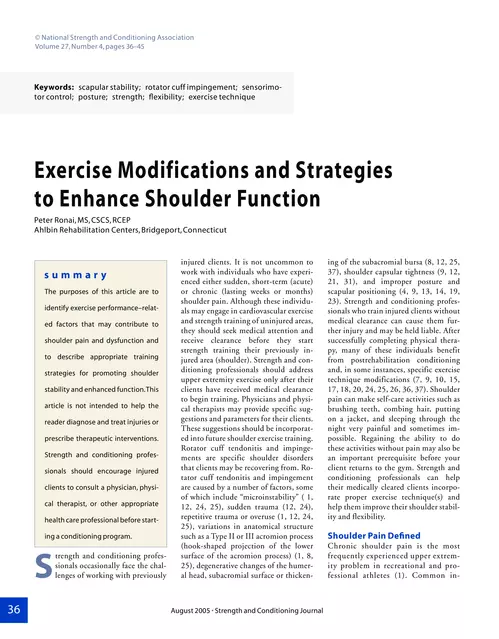
Exercise Modifications and Strategies to Enhance Shoulder Function
After an injury or surgery, an exercise conditioning program will help you return to daily activities Main muscles worked: Middle and lower trapezius.
adsPart of the document
Exercise Modifications and Strategies
to Enhance Shoulder Function
Peter Ronai,MS,CSCS,RCEP
Ahlbin Rehabilitation Centers,Bridgeport,Connecticut
© National Strength and Conditioning Association
Volume 27,Number 4,pages 36-45
Keywords:
scapular stability; rotator cuff impingement; sensorimo-
tor control; posture; strength; flexibility; exercise techniqueS
trength and conditioning profes-
sionals occasionally face the chal-
lenges of working with previouslyinjured clients. It is not uncommon to
work with individuals who have experi-
enced either sudden, short-term (acute)
or chronic (lasting weeks or months)
shoulder pain. Although these individu-
als may engage in cardiovascular exercise
and strength training of uninjured areas,
they should seek medical attention and
receive clearance before they start
strength training their previously in-
jured area (shoulder). Strength and con-
ditioning professionals should address
upper extremity exercise only after their
clients have received medical clearance
to begin training. Physicians and physi-
cal therapists may provide specific sug-
gestions and parameters for their clients.
These suggestions should be incorporat-
ed into future shoulder exercise training.
Rotator cuff tendonitis and impinge-
ments are specific shoulder disorders
that clients may be recovering from. Ro-
tator cuff tendonitis and impingement
are caused by a number of factors, some
of which include "microinstability" ( 1,
12, 24, 25), sudden trauma (12, 24),
repetitive trauma or overuse (1, 12, 24,
25), variations in anatomical structure
such as a Type II or III acromion process


